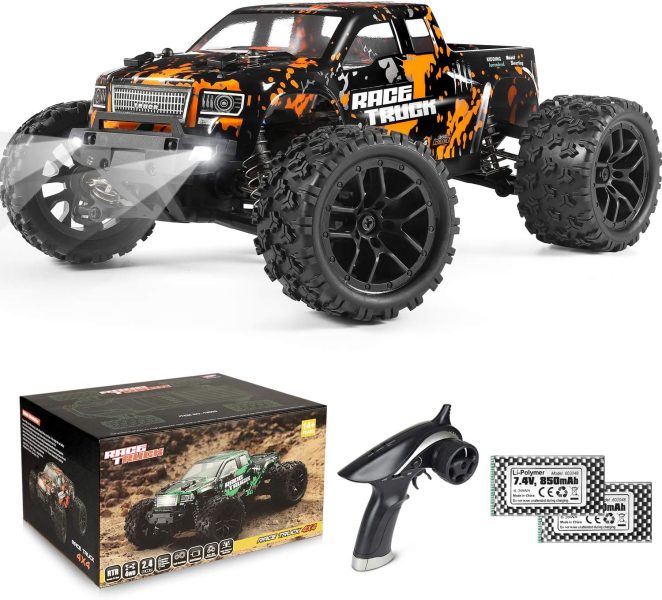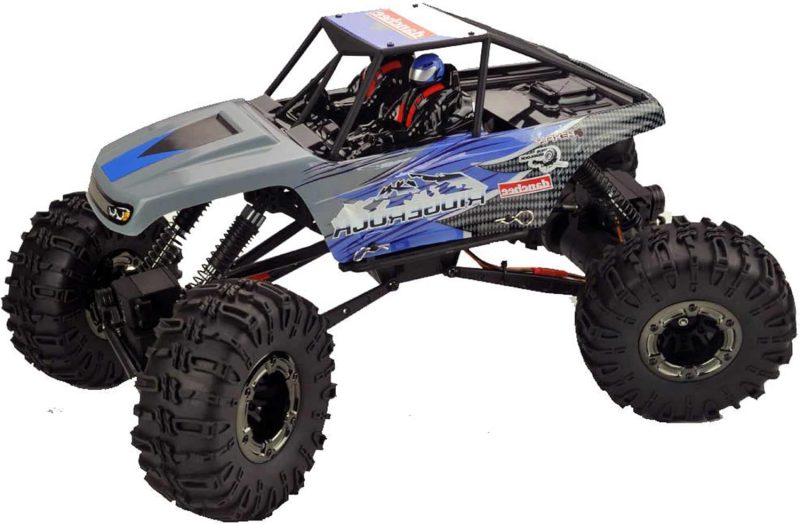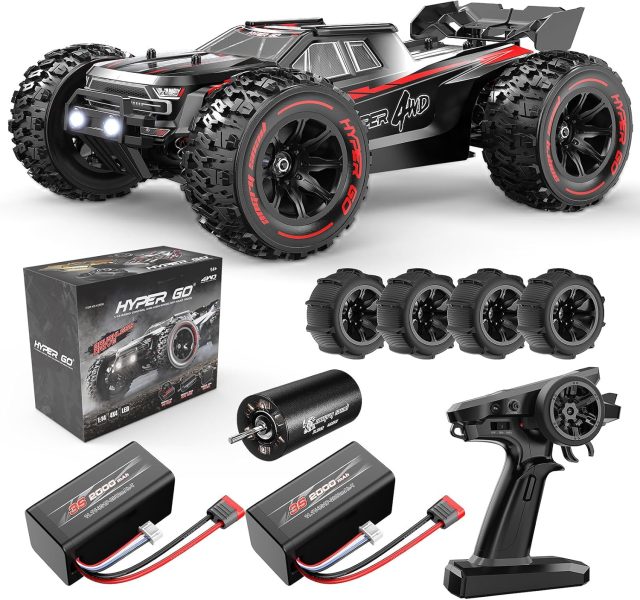Remote controlled (RC) off-road vehicles are a thrilling hobby for all ages. From crawling over rocky terrain to bashing through mud pits, RC vehicles provide an adrenaline rush. Two of the most popular types of off-road RC vehicles are crawlers and bashers. But what exactly is the difference between the two? This comprehensive guide will compare RC crawlers and bashers to help you decide which is better suited for your needs.
What is an RC Crawler?

RC crawlers are designed for slow technical driving over very rough terrain. They have a high ground clearance and four-wheel drive with articulating suspensions, allowing them to “crawl” up, down and over obstacles. Crawlers excel at climbing, both indoors and outdoors, with specialized tires and low gear ratios to give maximum control.
Here are the key features of RC crawlers:
- High ground clearance – Extended wheelbase and clearances of 3 inches or more allow crawling over larger objects.
- Slow speed – Crawlers are geared for slow precise driving rather than speed. Top speeds are typically under 5 mph. Slow speed improves control on technical terrain.
- 4WD or 6WD – Four wheel drive improves grip. Some larger scale crawlers add two extra “crawler” wheels for added stability.
- Articulated suspension – Independent suspension on all wheels with plenty of flex and travel lets each wheel adapt to the terrain.
- Low gear ratios – Very low gearing ratios provide torque for crawling and fine throttle control.
- Specialized tires – Sticky, lugged crawler tires provide grip on rocks and inclines.
RC crawlers are best suited for driving on rocks, scaling obstacles, and technical climbing challenges rather than speed or jumps.
What is an RC Basher?

RC bashers are designed for fast off-road driving and absorbing big jumps and crashes (“bashing” about). These versatile trucks come in 2WD or 4WD with rigid suspensions built for durability and speed.
Here are the key features of RC bashers:
- Higher top speed – Bashers are geared for higher speeds, typically 30+ mph for larger models. Speed provides thrills.
- Lower ground clearance – Ride height is lower to improve stability at speed. Clearances are 1-2 inches rather than 3+ inches.
- 2WD or 4WD – Two-wheel drive is more common for lower cost and simplicity. Four wheel drive improves traction and control.
- Rigid suspension – Suspension travel is lower and stiffer to withstand big jumps and crashes.
- Higher gear ratios – More emphasis is put on top speed through higher gearing rather than slow precision.
- Versatile tires – Medium lug tires provide decent grip on many surfaces.
Bashers are best for going fast, driving aggressively, jumping, and not worrying about damage from crashes. Durability is emphasized over finesse.
RC Crawler vs Basher: Key Differences
Crawler | Basher | |
|---|---|---|
| Speed | Very slow <5mph | Fast 30+ mph |
| Ground Clearance | 3+ inches | 1-2 inches |
| Suspension | Articulated and flexible | Rigid |
| Gearing | Low ratio for control | Jumping, bashing, and speed |
| Tires | Sticky and lugged | Medium lug versatile |
| Best For | Technical climbing and crawling | The low ratio for control |
In summary, crawlers specialize in low speed technical driving and climbing, while bashers focus on speed, jumps and durability. Let’s look at each in more detail.
Advantages of an RC Crawler

RC crawlers excel at climbing obstacles and tackling rough natural terrain thanks to their specialized features:
Precise Throttle Control – Low gear ratios allow very precise low speed throttle modulation for maneuvering on rocks or ascending steep inclines. Slow crawler speeds improve control.
Traction on Steep and Rocky Surfaces – The high torque and specialized sticky crawler tires provide excellent traction on rocks, gravel, and inclines beyond 45 degrees.
Maneuverability on Technical Terrain – The articulated suspensions on each wheel adapt to uneven terrain, keeping the chassis stable. This allows driving over larger obstacles.
Fun Scale Realism – The slow speed and working suspension create a realistic scaled down off-roading experience. Adding scale accessories enhances realism.
Crawlers shine for technical and realistic driving. Patience and precision are required, akin to the full-size rock crawling hobby. The sense of reward from spotting lines and conquering technical sections is unmatched.
Disadvantages of an RC Crawler
The trade-offs and disadvantages of RC crawlers include:
Not Fast – Low top speeds under 5 mph mean crawlers are very slow. This can be frustrating for those wanting speed and jumps.
Not Durable for Jumps – The flexible suspensions and scale accessories on crawlers are vulnerable to crash damage. Jumping is not recommended.
Less Versatile Tires – The sticky, lugged crawler tires excel off-road but ride poorly on pavement. Tires need swapping for street driving.
Higher Maintenance – The intricate suspension systems require more maintenance and cleaning to prevent debris buildup compared to simple bashers.
Less Beginner Friendly – Precise low speed driving takes practice. Crawlers have a steeper learning curve than fast bashers.
RC crawlers require accepting slower speeds in trade for vastly better technical terrain capabilities. Their scale realism and driving finesse come at the cost of durability concerns when driven aggressively.
Advantages of an RC Basher

RC bashers excel at going fast, absorbing big jumps, and powering through off-road terrain:
Speed and Excitement – With top speeds over 30mph, bashers provide a thrilling ride. Fast speeds allow big jumps and impressive air time.
Durability – Rigid suspensions and simple construction allow bashers to crash, roll, and abuse terrain with less damage or downtime. They are fun to drive hard.
Jumping Ability – The firm long travel suspensions provide stability for getting big air off jumps and landings. Bashers are built to take flight.
Beginner Friendly – Bashers are easier to control at speed. Throttle and steering input is more forgiving. This makes bashing better for beginners.
Tire Versatility – Medium lug tires provide decent grip on dirt, grass and pavement allowing bashers to run almost anywhere.
Bashers provide approachable fast-paced RC fun right out of the box. Durable construction and all-around capabilities make them ideal for new drivers and aggressive bashing alike.
Disadvantages of an RC Basher
The trade-offs and disadvantages of RC bashers include:
Lack Finesse – Their simple rigid suspensions and higher speeds sacrifice the control and realism of capable crawlers on technical terrain.
Worse Traction and Climbing – Less specialized tires and lower torque limit climbing compared to crawlers. Expect more getting stuck.
Higher Speed Challenges – Fast unfamiliar models can be harder to control than precise crawlers for beginners. Crashes happen more frequently.
Repairs and Upgrades – The focus on bashing durability over finesse means repairs after crashes are more likely. Upgrades are common.
Less Immersive – The lack of scale realism and more “toylike” bouncy feel creates less immersion than the driving experience of crawlers.
Bashers trade finesse and realism for speed and durability. Their capabilities require accepting more frequent crashes, repairs, and upgrades as part of the hobby.
Common RC Basher and Crawler Upgrades
Both bashers and crawlers can be upgraded to enhance durability, performance and appearance. Common upgrades include:
Tires – More aggressive bashers tires improve traction. Sticky comp crawler tires optimize grip. Street tread RC tires allow driving on pavement.
Batteries – Lithium polymer (LiPo) provides more power and faster recharge times. Heavier models benefit from multiple battery packs.
Shocks – Oil filled aluminum shocks increase travel and improve handling over stock plastic shocks.
Bearings – Steel ball bearings reduce friction and improve drivetrain efficiency. Good upgrade for both speed and crawling.
Chassis – Aluminum chassis improves crawler rigidity. Composite bashers chassis add resilience.
Drivetrain – Stronger metal transmission gears, drive shafts, and axles enhance durability.
Electronics – Improved transmitters extend range. Brushless motors boost power. Waterproofing allows wet running.
Appearance – Scale accessories like light bars improve crawler realism. Custom paint jobs and bodies personalize any RC.
Basher vs Crawler: Which is Right for You?
When choosing between purchasing an RC basher or crawler, consider how you plan to drive and your preferences:
- For technical terrain, rock crawling and scale realism, a crawler is the best choice.
- For high speed action and big air jumps with less finesse, a basher is ideal.
- Crawlers provide a patient, rewarding driving experience but require accepting slower speeds.
- Bashers deliver thrills through speed and freedom to drive aggressively. Frequent crashes and repairs should be expected.
- Consider the type of terrain you plan to run on most – rocky and steep areas favor crawlers, while wide open spaces suit faster bashers.
- Basher models tend to be cheaper than comparably sized crawlers, making them more budget-friendly.
- Look for 4WD if tackling rougher terrain. 2WD allows good performance at a lower cost.
- Brushless motor and LiPo battery upgrades can be added later to boost basher speed and crawler torque when desired.
In summary, those wanting a technical challenge will love the finesse of RC crawling. For wide open off-road fun and big air thrills, choose a durable RC basher instead. Pick what best fits your driving style. Both deliver an exciting taste of off-road action!
